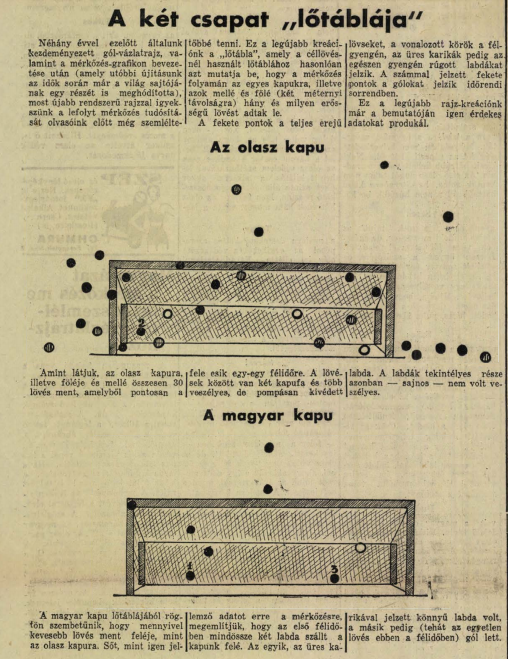本文主要是介绍匈牙利 系统装k3系统_匈牙利报纸的三项Sportviz发明,希望对大家解决编程问题提供一定的参考价值,需要的开发者们随着小编来一起学习吧!
匈牙利 系统装k3系统
A couple of days ago, two of my friends, independently from each other, sent me a graph published by Hungarian sports daily newspaper Nemzeti Sport (National Sport) in 1927. The line graph shows the most important events during the 90-minute football match between Hungary and France on June 12, 1927. Hungary won the match 13 to 1 against France. This was one of the highlights of Hungarian football!
几天前,我的两个朋友彼此独立地给我寄了一张1927年由匈牙利体育日报Nemzeti Sport ( National Sport )发布的图表。该线图显示了90分钟足球比赛期间最重要的事件匈牙利和法国在1927年6月12日之间进行对抗。匈牙利在对法国的比赛中以13比1赢得了比赛。 这是匈牙利足球的亮点之一!

The graphs above show the two 45-minute halves of the 90-min football match in a horizontal layout. A centerline divides the graphs into two halves of the pitch according to the two teams’ position. The circles show the shots on goal, and the circles in the square show the goals scored. Flags are offsides, crosses are free kicks.
上图以水平布局显示了90分钟足球比赛的两个45分钟半。 中心线根据两支球队的位置将图表分为两半。 圆圈显示射门得分,正方形圆圈显示进球得分。 旗帜是越位,十字架是任意球。
Since I’ve never seen anything quite similar, I did a little research on Hungarian digital archives Arcanum, and what I’ve found is really amazing. I’d like to thank a colleague at Lechner Center of Architecture for the discovery. It turned out that Nemzeti Sport published these kind of “match graphs” from 1922, for which I counted more than 30 of them until 1940s. These match graphics also used to be on the front page, which is very unusual, even nowadays.
由于从未见过类似的东西,因此我对匈牙利数字档案馆Arcanum进行了一些研究,发现的确令人惊奇。 我要感谢莱希纳建筑中心的一位同事的发现。 事实证明, Nemzeti Sport从1922年开始发布了此类“匹配图”,直到1940年代,我一直为其中数到30个。 这些匹配的图形也曾经出现在首页上,即使在今天也很不寻常。


But the most thrilling is, that one and a half years later, in 1925, the newspaper announced proudly that their creation made a huge carrier in several countries. According to Nemzeti Sport, other sport dailies, like the Gazzetta dello Sport in Italy, or the Idrottsbladet in Sweden, started to publish similar graphs. They wrote that “when we created the graph, we knew, that what we did, had sport-historical importance.” This underlines that this is no short feat for Nemzeti Sport. Unfortunately, I couldn’t find similar graphs from other gazettes and newspapers from the era in the digital archives. I especially looked for the Idrottsbladet and the Gazzetta dello Sport.
但最令人振奋的是,在一年半之后的1925年,该报自豪地宣布,他们的创作在多个国家/地区成为了巨大的载体。 根据Nemzeti Sport的说法,其他体育日报,例如意大利的Gazzetta dello Sport或瑞典的Idrottsbladet ,也开始发布类似的图表。 他们写道: “当我们创建图表时,我们知道所做的事情具有体育历史意义。” 这突显了这对于Nemzeti Sport而言并非短短的壮举。 不幸的是,我在数字档案馆中找不到那个时代其他公报和报纸的类似图表。 我特别寻找Idrottsbladet和Gazzetta dello Sport 。

As I turned the pages in the archives, a new visualization appeared in an issue from 1936 with a text announcing that “after the international success of the match graphs we created a new visual invention, the target table.”
当我翻阅档案中的页面时,1936年的一期杂志中出现了一种新的可视化效果,并显示了文字: “在匹配图获得国际成功之后,我们创建 了一个新的可视化发明,即目标表 。”

On the image we can see two goals: the top one is Italy’s, and the one below it Hungary’s. The text explains that the black circles are the power shots, the ruled ones are the “semi-weak” shots, and the empty ones are the really weak shots. The scores are numbered in order. From the visualization we can see that while Hungary had more occasions for scoring, also hitting the goal post twice, Italy took better advantage of their opportunities and won this match 2–1 against Hungary.
在图像上,我们可以看到两个目标:最高的是意大利的目标,而下方的是匈牙利的目标。 文字解释说,黑眼圈是强力镜头,有规则的是“半弱”镜头,而空的是真正的弱镜头。 分数按顺序编号。 从可视化中我们可以看到,尽管匈牙利有更多的得分机会,也两次打进了球门柱,但意大利却更好地利用了他们的机会,并以2比1战胜了匈牙利。

In 1942, the Nemzeti Sport came out with the improved version of the target table. Since the newspaper did not give it a specific name, the directional target table is my denomination. Again a self-congratulatory quote by the Nemzeti newspaper, in a very kitschy and pompous Hungarian yet lost in translation: “Our graph shows the waves of the match, and our target table was appreciated in all Europe. From Italy to Sweden, from Portugal to Romania, sport newspapers adopted them everywhere. We hope that our readers will appreciate our new target table, which shows not only the hitting points, but also the direction and the distance where the shot or the header came from.”
1942年, Nemzeti Sport推出了目标桌的改良版。 由于报纸未提供具体名称,因此定向目标表是我的教派。 Nemzeti报纸再次自我祝贺,引用了一个非常粗俗而又自负的匈牙利语,但在翻译中却迷失了方向: “我们的图表显示了比赛的浪潮,我们的目标桌在整个欧洲都受到赞赏。 从意大利到瑞典,从葡萄牙到罗马尼亚,体育报纸到处都采用了它们。 我们希望读者会喜欢我们的新目标表,它不仅显示击球点,而且还显示击球或标头的出射方向和距离。”

Sadly, the newspaper did not disclose who created these graphs. And we can’t be sure that these graphs were truly the first of their kind.
可悲的是,报纸没有透露是谁创造了这些图表。 而且我们不能确定这些图确实是同类中的第一个。
I still feel a final remark is necessary. A few comments on my original Hungarian post on Facebook suggested that there was a correlation between using innovative visual analytics of match data and the good performance of the Hungarian football. An underlining thought was that the Hungarian team or the soccer organization had generous amounts of data on the match and the players to create such graphics. However, I’m unsure if this is the case. No matter, Hungary did reach the World Cup final in 1938. Although it lost again in a match versus Italy, it remains a golden era for Hungarian soccer/football.
我仍然觉得有最后一句话是必要的。 在我最初在匈牙利的匈牙利帖子中发表的一些评论表明,使用创新的比赛数据可视化分析与匈牙利足球的良好表现之间存在关联。 一个突出的想法是匈牙利队或足球组织在比赛和球员上有大量数据来创建这样的图形。 但是,我不确定是否是这种情况。 没关系,匈牙利确实在1938年闯入了世界杯决赛。尽管匈牙利在与意大利的比赛中再次失利,但这仍然是匈牙利足球的黄金时代。

翻译自: https://medium.com/nightingale/three-sportviz-inventions-by-a-hungarian-newspaper-b5c0df489d6c
匈牙利 系统装k3系统
相关文章:
这篇关于匈牙利 系统装k3系统_匈牙利报纸的三项Sportviz发明的文章就介绍到这儿,希望我们推荐的文章对编程师们有所帮助!




